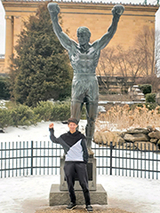CHOP’s First Ozaki Procedure: Sam’s Story
CHOP’s First Ozaki Procedure: Sam’s Story
At 10 years old, Sam was a highly competitive athlete, playing all-star baseball, soccer and basketball. When, in 2016, episodes of chest pains and difficulty breathing led to an evaluation by a pediatric cardiologist in the family’s Montana hometown, Sam was diagnosed with a bicuspid aortic valve (an aortic valve with only two leaflets instead of three) and aortic stenosis. Suddenly, it wasn’t safe for Sam to risk impact to his chest, and sports came to an immediate halt. “The doctor said he could play golf or do yoga,” says Sam’s mom, Nicole.

Sam would eventually need an aortic valve repair, and his parents, Nicole and Matt, began to research their options. When Sam and Matt took a tour of a Seattle hospital, they met with Jonathan Chen, MD, who at that time served as the hospital’s Chief of Congenital Cardiac Surgery and Co-director of the Heart Center. Dr. Chen told them about a relatively new surgical technique called the Ozaki procedure, developed by Shigeo Ozaki, MD in 2007.
The Ozaki procedure uses a patient's own pericardium to create three leaflets for a new heart valve. Unlike common alternatives, the Ozaki procedure does not require a patient to take lifelong anticoagulants, as in the case of mechanical valve replacement, and does not involve the additional reconstruction of the pulmonary valve, which is required in the commonly used Ross procedure. In addition, the new leaflets are constructed in a way that allows for continued growth of the heart, potentially extending the life of the repair.
“I was convinced of Dr. Ozaki’s philosophy,” says Matt. “We felt this was the right thing for Sam.”
Watching and waiting
Though the family had settled on a treatment path for Sam, his doctors agreed it would be best to wait and allow Sam’s heart to grow closer to adult size, limiting the likelihood of future surgeries. For the next four years, Sam was monitored by his Montana cardiologist. At each visit, Sam would ask for a stress test in hopes he’d be cleared to play sports, and at each visit, he was disappointed.
While Sam never took up golf or yoga, he remained active by working on strength building. Allowed to run in gym class, Sam was the fastest in his class, even with a heart condition. He also developed other interests, including playing the piano and drums and producing his own music.
When the news came in Nov. 2020 that Sam would need surgery within the next six months, he was thrilled. “I got really happy,” says Sam. “It relieved a lot of anxiety. I wanted to get the surgery done.”
First in Medicine, Fueled by Philanthropy
Your gift funds breakthrough interventions that improve and save the lives of children like Sam with heart disease.
‘Everything was a green light.’
Dr. Chen, however, no longer worked in Washington. Having relocated across the country to Children’s Hospital of Philadelphia (CHOP), Dr. Chen was now Co-director of the Cardiac Center and Chief of the Division of Cardiothoracic Surgery. This did not deter Matt and Nicole, who knew few hospitals offer the Ozaki procedure.
Sam’s surgery would take place in Philadelphia at CHOP’s Topolewski Pediatric Heart Valve Center, where a multidisciplinary team co-led by Dr. Chen takes an innovative, comprehensive approach to treating valve disease.
Traveling from rural Montana to Philadelphia during a pandemic, however, would not be easy. The closest airport was at least two hours away. There were other challenges, including lining up care for Sam’s two older brothers, but with the assistance of CHOP’s hospitality navigators who helped the family plan their stay, the trip to Philadelphia was finally arranged.
“At the end of the day, everything was a green light,” says Nicole.
A hero’s journey
Sam’s six-hour procedure was performed by Dr. Chen and Muhammed Nuri, MD, Surgical Director of the Topolewski Pediatric Heart Valve Center. Sam’s parents passed the time posting online updates to their wide support community. When Dr. Chen discussed the surgery’s outcome with Matt and Nicole, he showed them a video of the repaired valve opening and closing — the very first Ozaki procedure performed at CHOP. “It’s perfect,” Dr. Chen told them.

While the first few days of recovery were difficult, Sam quickly began to improve and was discharged less than a week later.
The family had friends in Philadelphia and a took a brief tour of the city before heading back to Montana. At the art museum, Sam begged his parents to climb the famed 72 “Rocky Steps.” Though Nicole only agreed for him to climb a few steps, Sam darted to the top, where he posed for a picture in front of the fictional boxer’s statue and plaque that reads: “It’s not how hard you hit, it’s how hard you can get hit and keep moving forward — that’s how winning is done.”
Back home, Sam, now 14, recently had a post-op visit with his hometown cardiologist. Though he has a few more months of at-home recovery and medical follow-ups ahead, Sam was thrilled to finally hear his doctor ask, “Are you ready to play basketball in the fall?”